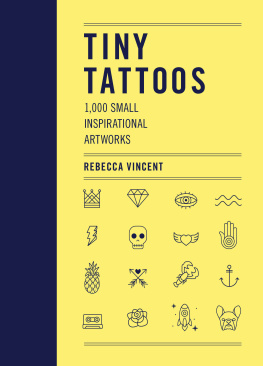Veils, Nudity, and Tattoos
Veils, Nudity, and Tattoos
The New Feminine Aesthetics
Thorsten Botz-Bornstein
LEXINGTON BOOKS
Lanham Boulder New York London
Chapter 1 originally published as Veils and Sunglasses by Thorsten Botz-Bornstein. The Journal of Aesthetics and Culture 20:2, 2012.
Chapter 3 originally published as Can the Veil be Cool? by Thorsteon Botz-Bornstein. Journal of Religion and Popular Culture 25:2. The University of Toronto Press, 2013. Reprinted with permission from Univeristy of Toronto Press (utpjournals.com).
Chapter 7 originally published as From the Stigmatized Tattoo to the Graffitied Body: Femininity in the Tattoo Renaissance by Thorsten Botz-Bornstein. Gender, Place, and Culture: A Journal of Feminist Geography 20:2. Taylor & Francis, 2013. Reprinted by permission of Taylor & Francis Ltd, www.tandfonline.com.
Published by Lexington Books
An imprint of The Rowman & Littlefield Publishing Group, Inc.
4501 Forbes Boulevard, Suite 200, Lanham, Maryland 20706
www.rowman.com
Unit A, Whitacre Mews, 26-34 Stannary Street, London SE11 4AB
Copyright 2015 by Lexington Books
All rights reserved. No part of this book may be reproduced in any form or by any electronic or mechanical means, including information storage and retrieval systems, without written permission from the publisher, except by a reviewer who may quote passages in a review.
British Library Cataloguing in Publication Information Available
Library of Congress Cataloging-in-Publication Data
Botz-Bornstein, Thorsten.
Veils, nudity, and tattoos : the new feminine aesthetic / Thorsten Botz-Bornstein.
pages cm.
Includes bibliographical references and index.
ISBN 978-1-4985-0046-3 (cloth : alk. paper) -- ISBN 978-1-4985-0047-0 (electronic) 1. Body marking. 2. Tattooing. 3. Veils. 4. Body image. 5. Human body--Social aspects. I. Title.
GN419.15.B68 2015
391.6'5--dc23
2015021048
 TM The paper used in this publication meets the minimum requirements of American National Standard for Information Sciences Permanence of Paper for Printed Library Materials, ANSI/NISO Z39.48-1992.
TM The paper used in this publication meets the minimum requirements of American National Standard for Information Sciences Permanence of Paper for Printed Library Materials, ANSI/NISO Z39.48-1992.
Printed in the United States of America
Acknowledgments
I would like to thank the following journals for having granted the permission to reprint revised versions of their articles: Gender, Place and Culture: A Journal of Feminist Geography, which published From the Stigmatized Tattoo to the Graffitied Body: Femininity in the Tattoo Renaissance (now chapter 7) in its 20:2, 2012 issue; the Journal of Aesthetics and Culture, which published Veils and Sunglasses (now chapter 1) in its 5, 2013 issue; and the Journal of Religion and Popular Culture, which published Can the Veil be Cool? (whose much extended version is now chapter 3) in its 25:2, 2013 issue.
Introduction
This is a philosophical book about two aesthetic devices that seem to be diametrically opposed: nudity and veiling. Tattoos settle somewhere in the middle between both. At first sight, tattoos, nudity, and veils do not seem to have much in common except for the fact that all three have become more frequent, more visible, and more dominant in connection with aesthetic presentations of women over the last thirty years. Still there are links. In 2013, Nicola Formichetti, the new artistic director of the fashion brand Diesel, launched his first advertisement campaign called Dieselreboot using bold iconography employing tattoos, nudity, and veils. What can appear as an artistic whim is held together by profound relationships that this book attempts to reveal through a conceptual analysis.
In October 2011, twenty-year-old Aliaa El Mahdy posted her nude photo on her blogspot page, arousing the anger of the conservative part of Muslim society. In this photo, El Mahdy, dis-objectifies and desexualizes her body not through the device of decontextualization, but rather through an act of semantic inversion by presenting her body precisely in a way that is normally associated with objectification. This she has in common with many tattooed women and re-veiled women. The example shows that today more than ever it is necessary to think woman outside those boxes that attribute her to either conservatism or progressivism. In other words, tattoos, nudity, and veils need to be wrenched from essentialized discourses that look either for the authentic, natural, traditional, and morally correct expression or for its contrary.
The present book sketches the image of a woman who is not only sexually emancipated and confident, but also more and more aware of her cultural heritage. By doing so, she takes an unorthodox approach towards three phenomena that conventional ways of thinking tend to see as unrelated or even opposed.
What do tattoos, nudity, and veils have in common? All three concern the skin, are unconventional fashion objects, establish identity, and are linked to certain taboos. All three are private and public, humiliating and empowering, as well as backward and progressive according to the interpretation to which they are submitted. Furthermore, all three phenomena have considerably changed during the last thirty years, which makes comparisons possible. Nudity no longer represents a natural state of the body but rather detracts from nature. Still, it has a highly ideological value. On the radical feminist protest group FEMENs posters, one can read Naked Truth or Nudity Is Freedom. This books purpose is to show that the veil has become part and parcel of a new script of body culture similar to nudity and tattoos. Though nudity still decolonizes the body, the nude can no longer be seen as pure; and tattoos and veils have developed in parallel with this cultural shift. As a result, all three phenomena need to be read in the same context. The chapters of this book will reveal many paradoxes revolving around respect, modesty, sexuality, female power, and female non-power. It will become clear that the only logic able to approach this world of paradoxes is the complex logic of Third Wave feminism that challenges dualism by recognizing diversity, particularity, and embodiment.
In order to understand the new constellations by which tattoos, nudity, and veils are determined, certain tropes need to be deconstructed beforehand. These include the trope of Western civilization vs. Oriental barbarism, the trope of the Muslim woman as the ultimate victim of an Islamic patriarchy, but also the trope of covering as an advancement of civilization. It is not enough to insist on tradition and to refuse so-called Western values.
Against this background, the questions asked in this book turn out to have a broad anthropological scope: What relationships do tattoos, nudity, and veils have with civilization? Is nudity itself primitive and does the covering (veiling) of nudity signify a step towards civilization or a step away from it? Do tattoos effectuate a shift from the primitive to civilization or does the untattooed, pure skin represent a supreme civilizational value even in contemporary postmodern culture? What will become obvious is that in contemporary culture neither the naked nor the nude can be seen as pure. Nudity no longer functions as an ideal of civilization (or non-civilization) in the classical sense. As a consequence, the cancellation of essentialized notions of nature that were still current during modernity has also inaugurated a new approach towards tattoos and nudity.
Next page











 TM The paper used in this publication meets the minimum requirements of American National Standard for Information Sciences Permanence of Paper for Printed Library Materials, ANSI/NISO Z39.48-1992.
TM The paper used in this publication meets the minimum requirements of American National Standard for Information Sciences Permanence of Paper for Printed Library Materials, ANSI/NISO Z39.48-1992.